University Business Law Assignment 1: Torts, Negligence, and Defenses
VerifiedAdded on 2022/08/15
|5
|1097
|14
Homework Assignment
AI Summary
This assignment solution addresses key aspects of business law, focusing on negligence and torts. It begins with a case study involving ABC Fine Porcelain Ltd. and DEF Transport Company, analyzing claims of nuisance and trespass, referencing the case of TMS Lighting Ltd v KJS Transport. The solution then explores the elements of negligence, as established in Donoghue v Stevenson, and the Caparo test for determining negligence. The assignment further delves into the 'thin skull rule' and the 'crumbling skull rule', explaining their differences. Finally, it covers various defenses in negligence cases, including contributory negligence, comparative negligence, and assumption of risk, providing detailed explanations and relevant legal precedents.
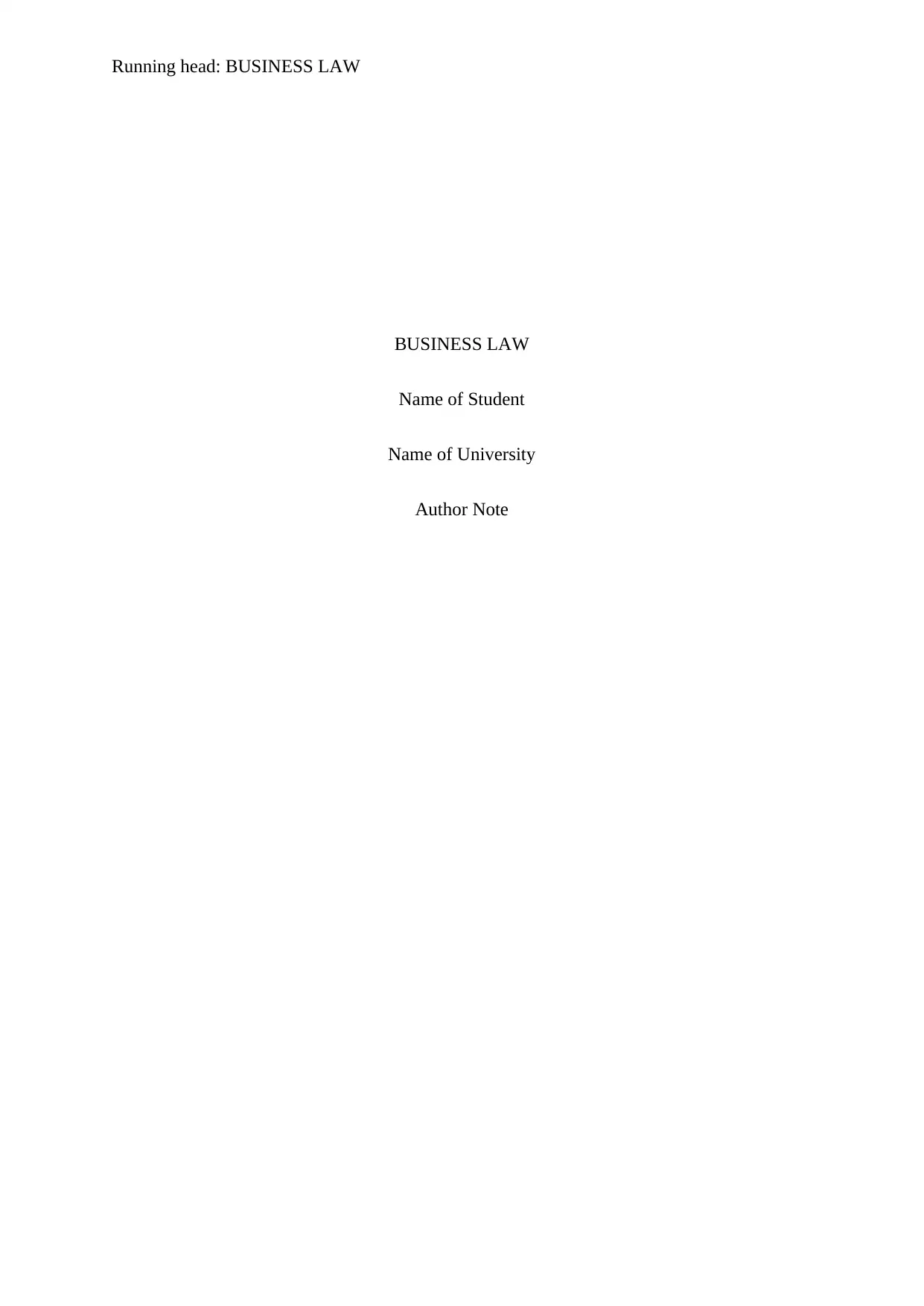
Running head: BUSINESS LAW
BUSINESS LAW
Name of Student
Name of University
Author Note
BUSINESS LAW
Name of Student
Name of University
Author Note
Paraphrase This Document
Need a fresh take? Get an instant paraphrase of this document with our AI Paraphraser
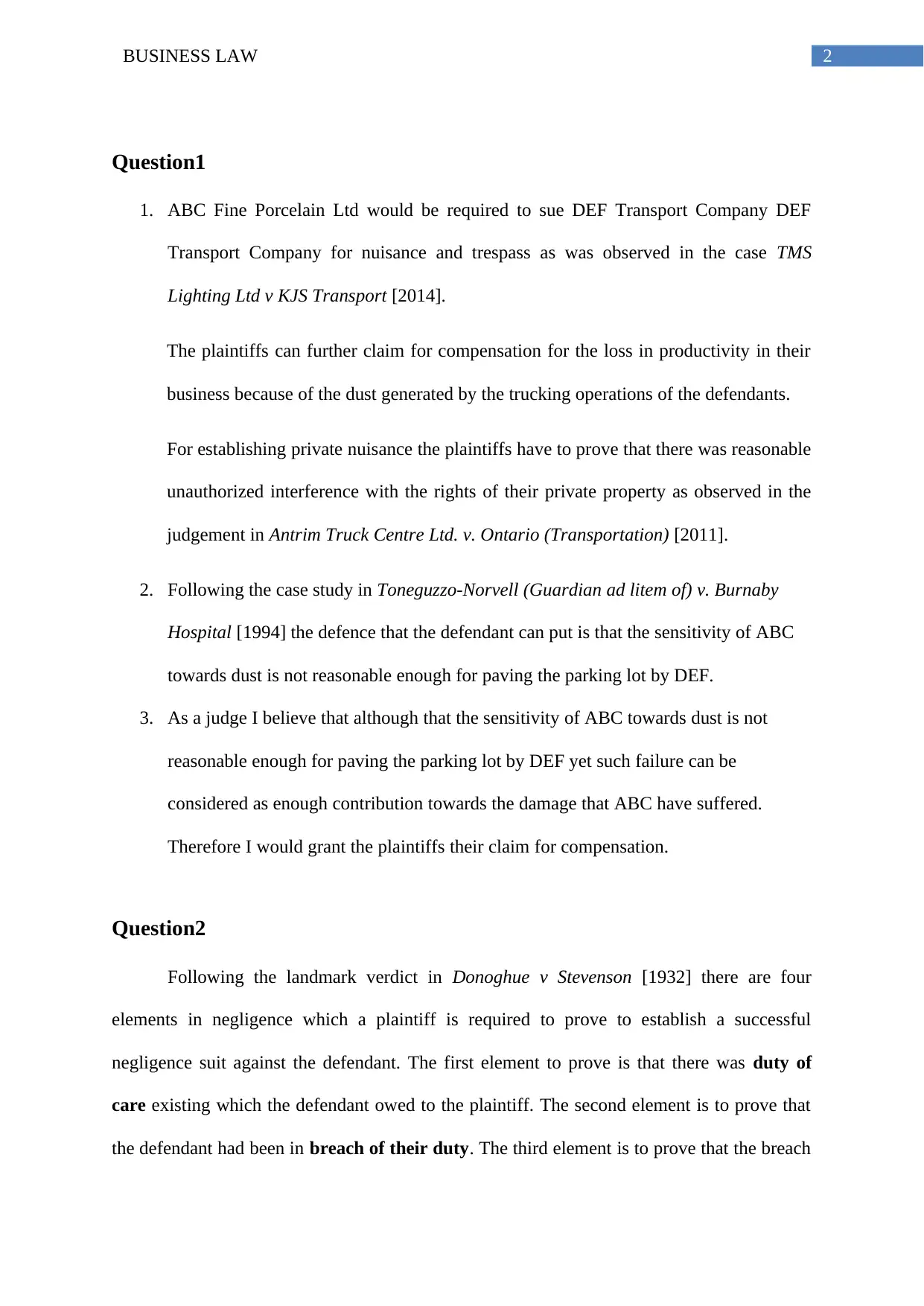
2BUSINESS LAW
Question1
1. ABC Fine Porcelain Ltd would be required to sue DEF Transport Company DEF
Transport Company for nuisance and trespass as was observed in the case TMS
Lighting Ltd v KJS Transport [2014].
The plaintiffs can further claim for compensation for the loss in productivity in their
business because of the dust generated by the trucking operations of the defendants.
For establishing private nuisance the plaintiffs have to prove that there was reasonable
unauthorized interference with the rights of their private property as observed in the
judgement in Antrim Truck Centre Ltd. v. Ontario (Transportation) [2011].
2. Following the case study in Toneguzzo-Norvell (Guardian ad litem of) v. Burnaby
Hospital [1994] the defence that the defendant can put is that the sensitivity of ABC
towards dust is not reasonable enough for paving the parking lot by DEF.
3. As a judge I believe that although that the sensitivity of ABC towards dust is not
reasonable enough for paving the parking lot by DEF yet such failure can be
considered as enough contribution towards the damage that ABC have suffered.
Therefore I would grant the plaintiffs their claim for compensation.
Question2
Following the landmark verdict in Donoghue v Stevenson [1932] there are four
elements in negligence which a plaintiff is required to prove to establish a successful
negligence suit against the defendant. The first element to prove is that there was duty of
care existing which the defendant owed to the plaintiff. The second element is to prove that
the defendant had been in breach of their duty. The third element is to prove that the breach
Question1
1. ABC Fine Porcelain Ltd would be required to sue DEF Transport Company DEF
Transport Company for nuisance and trespass as was observed in the case TMS
Lighting Ltd v KJS Transport [2014].
The plaintiffs can further claim for compensation for the loss in productivity in their
business because of the dust generated by the trucking operations of the defendants.
For establishing private nuisance the plaintiffs have to prove that there was reasonable
unauthorized interference with the rights of their private property as observed in the
judgement in Antrim Truck Centre Ltd. v. Ontario (Transportation) [2011].
2. Following the case study in Toneguzzo-Norvell (Guardian ad litem of) v. Burnaby
Hospital [1994] the defence that the defendant can put is that the sensitivity of ABC
towards dust is not reasonable enough for paving the parking lot by DEF.
3. As a judge I believe that although that the sensitivity of ABC towards dust is not
reasonable enough for paving the parking lot by DEF yet such failure can be
considered as enough contribution towards the damage that ABC have suffered.
Therefore I would grant the plaintiffs their claim for compensation.
Question2
Following the landmark verdict in Donoghue v Stevenson [1932] there are four
elements in negligence which a plaintiff is required to prove to establish a successful
negligence suit against the defendant. The first element to prove is that there was duty of
care existing which the defendant owed to the plaintiff. The second element is to prove that
the defendant had been in breach of their duty. The third element is to prove that the breach
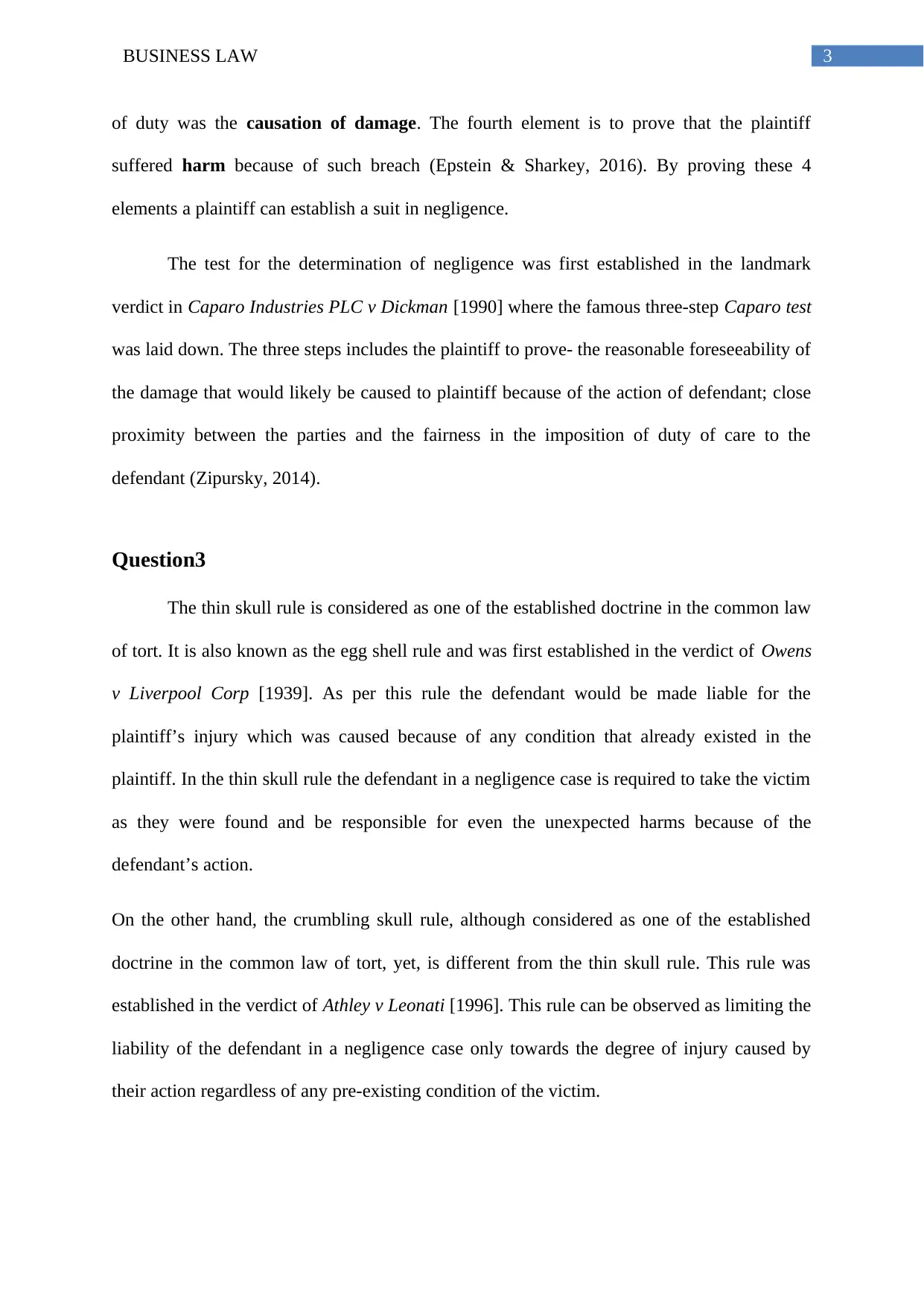
3BUSINESS LAW
of duty was the causation of damage. The fourth element is to prove that the plaintiff
suffered harm because of such breach (Epstein & Sharkey, 2016). By proving these 4
elements a plaintiff can establish a suit in negligence.
The test for the determination of negligence was first established in the landmark
verdict in Caparo Industries PLC v Dickman [1990] where the famous three-step Caparo test
was laid down. The three steps includes the plaintiff to prove- the reasonable foreseeability of
the damage that would likely be caused to plaintiff because of the action of defendant; close
proximity between the parties and the fairness in the imposition of duty of care to the
defendant (Zipursky, 2014).
Question3
The thin skull rule is considered as one of the established doctrine in the common law
of tort. It is also known as the egg shell rule and was first established in the verdict of Owens
v Liverpool Corp [1939]. As per this rule the defendant would be made liable for the
plaintiff’s injury which was caused because of any condition that already existed in the
plaintiff. In the thin skull rule the defendant in a negligence case is required to take the victim
as they were found and be responsible for even the unexpected harms because of the
defendant’s action.
On the other hand, the crumbling skull rule, although considered as one of the established
doctrine in the common law of tort, yet, is different from the thin skull rule. This rule was
established in the verdict of Athley v Leonati [1996]. This rule can be observed as limiting the
liability of the defendant in a negligence case only towards the degree of injury caused by
their action regardless of any pre-existing condition of the victim.
of duty was the causation of damage. The fourth element is to prove that the plaintiff
suffered harm because of such breach (Epstein & Sharkey, 2016). By proving these 4
elements a plaintiff can establish a suit in negligence.
The test for the determination of negligence was first established in the landmark
verdict in Caparo Industries PLC v Dickman [1990] where the famous three-step Caparo test
was laid down. The three steps includes the plaintiff to prove- the reasonable foreseeability of
the damage that would likely be caused to plaintiff because of the action of defendant; close
proximity between the parties and the fairness in the imposition of duty of care to the
defendant (Zipursky, 2014).
Question3
The thin skull rule is considered as one of the established doctrine in the common law
of tort. It is also known as the egg shell rule and was first established in the verdict of Owens
v Liverpool Corp [1939]. As per this rule the defendant would be made liable for the
plaintiff’s injury which was caused because of any condition that already existed in the
plaintiff. In the thin skull rule the defendant in a negligence case is required to take the victim
as they were found and be responsible for even the unexpected harms because of the
defendant’s action.
On the other hand, the crumbling skull rule, although considered as one of the established
doctrine in the common law of tort, yet, is different from the thin skull rule. This rule was
established in the verdict of Athley v Leonati [1996]. This rule can be observed as limiting the
liability of the defendant in a negligence case only towards the degree of injury caused by
their action regardless of any pre-existing condition of the victim.
⊘ This is a preview!⊘
Do you want full access?
Subscribe today to unlock all pages.

Trusted by 1+ million students worldwide
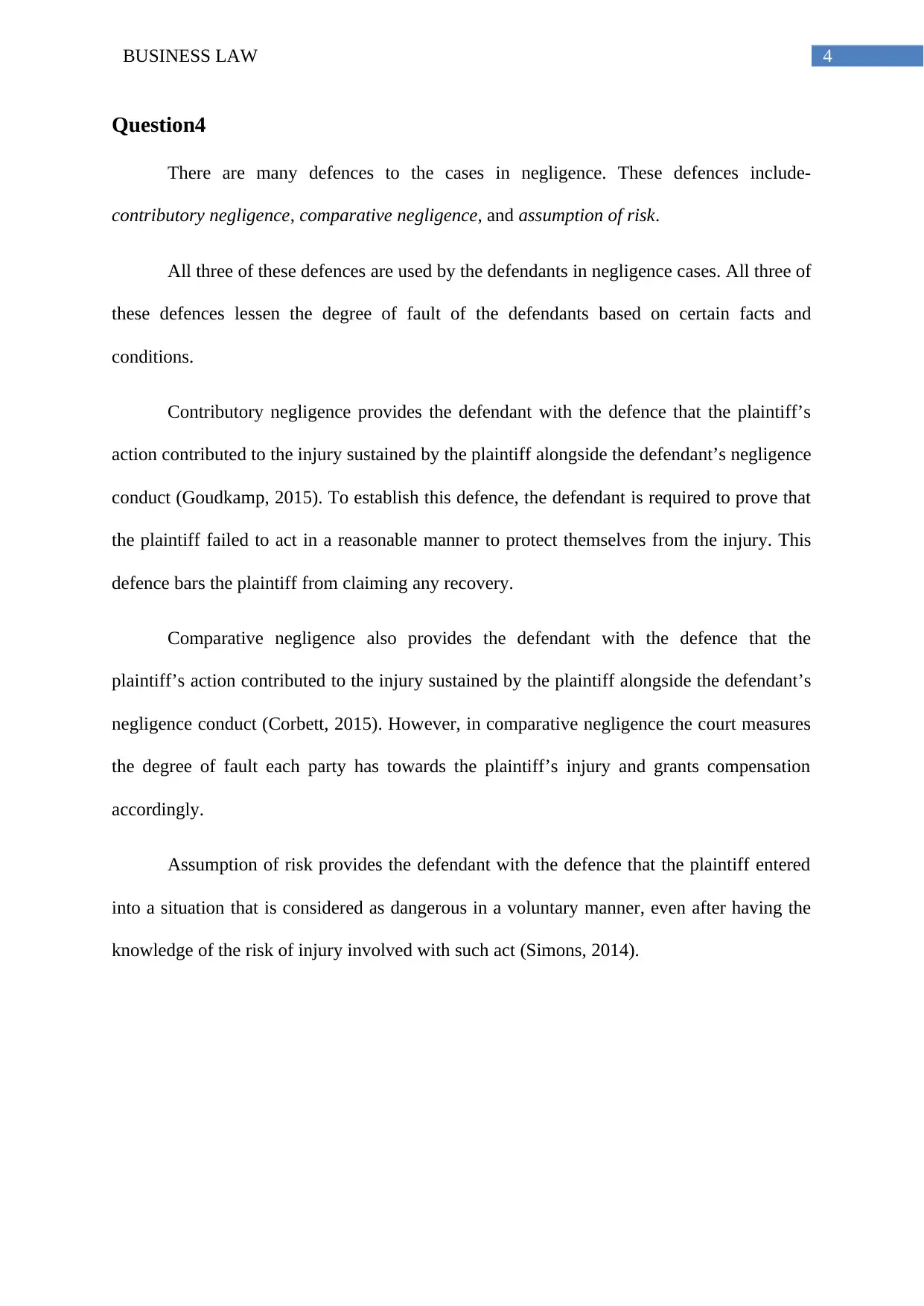
4BUSINESS LAW
Question4
There are many defences to the cases in negligence. These defences include-
contributory negligence, comparative negligence, and assumption of risk.
All three of these defences are used by the defendants in negligence cases. All three of
these defences lessen the degree of fault of the defendants based on certain facts and
conditions.
Contributory negligence provides the defendant with the defence that the plaintiff’s
action contributed to the injury sustained by the plaintiff alongside the defendant’s negligence
conduct (Goudkamp, 2015). To establish this defence, the defendant is required to prove that
the plaintiff failed to act in a reasonable manner to protect themselves from the injury. This
defence bars the plaintiff from claiming any recovery.
Comparative negligence also provides the defendant with the defence that the
plaintiff’s action contributed to the injury sustained by the plaintiff alongside the defendant’s
negligence conduct (Corbett, 2015). However, in comparative negligence the court measures
the degree of fault each party has towards the plaintiff’s injury and grants compensation
accordingly.
Assumption of risk provides the defendant with the defence that the plaintiff entered
into a situation that is considered as dangerous in a voluntary manner, even after having the
knowledge of the risk of injury involved with such act (Simons, 2014).
Question4
There are many defences to the cases in negligence. These defences include-
contributory negligence, comparative negligence, and assumption of risk.
All three of these defences are used by the defendants in negligence cases. All three of
these defences lessen the degree of fault of the defendants based on certain facts and
conditions.
Contributory negligence provides the defendant with the defence that the plaintiff’s
action contributed to the injury sustained by the plaintiff alongside the defendant’s negligence
conduct (Goudkamp, 2015). To establish this defence, the defendant is required to prove that
the plaintiff failed to act in a reasonable manner to protect themselves from the injury. This
defence bars the plaintiff from claiming any recovery.
Comparative negligence also provides the defendant with the defence that the
plaintiff’s action contributed to the injury sustained by the plaintiff alongside the defendant’s
negligence conduct (Corbett, 2015). However, in comparative negligence the court measures
the degree of fault each party has towards the plaintiff’s injury and grants compensation
accordingly.
Assumption of risk provides the defendant with the defence that the plaintiff entered
into a situation that is considered as dangerous in a voluntary manner, even after having the
knowledge of the risk of injury involved with such act (Simons, 2014).
Paraphrase This Document
Need a fresh take? Get an instant paraphrase of this document with our AI Paraphraser
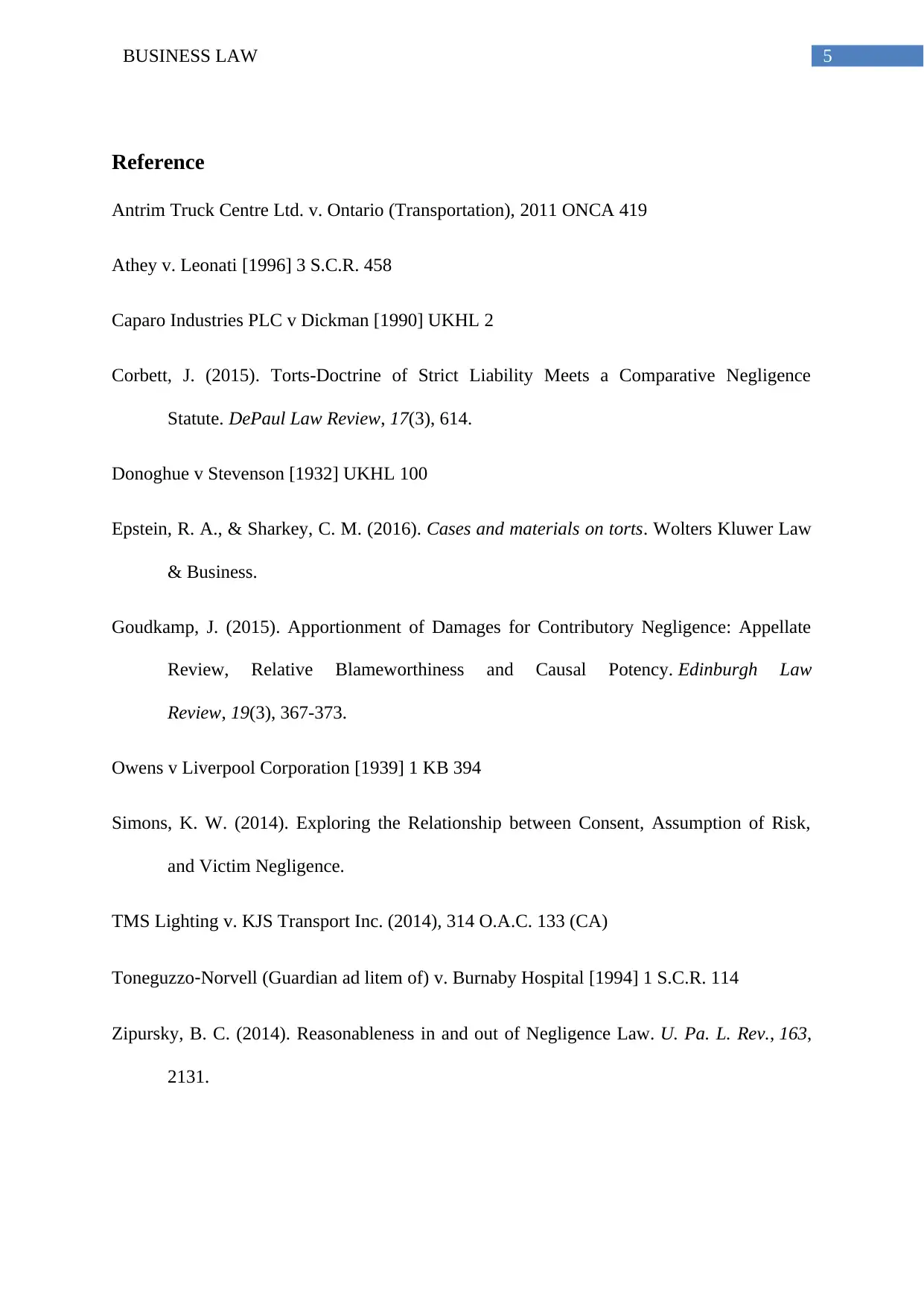
5BUSINESS LAW
Reference
Antrim Truck Centre Ltd. v. Ontario (Transportation), 2011 ONCA 419
Athey v. Leonati [1996] 3 S.C.R. 458
Caparo Industries PLC v Dickman [1990] UKHL 2
Corbett, J. (2015). Torts-Doctrine of Strict Liability Meets a Comparative Negligence
Statute. DePaul Law Review, 17(3), 614.
Donoghue v Stevenson [1932] UKHL 100
Epstein, R. A., & Sharkey, C. M. (2016). Cases and materials on torts. Wolters Kluwer Law
& Business.
Goudkamp, J. (2015). Apportionment of Damages for Contributory Negligence: Appellate
Review, Relative Blameworthiness and Causal Potency. Edinburgh Law
Review, 19(3), 367-373.
Owens v Liverpool Corporation [1939] 1 KB 394
Simons, K. W. (2014). Exploring the Relationship between Consent, Assumption of Risk,
and Victim Negligence.
TMS Lighting v. KJS Transport Inc. (2014), 314 O.A.C. 133 (CA)
Toneguzzo-Norvell (Guardian ad litem of) v. Burnaby Hospital [1994] 1 S.C.R. 114
Zipursky, B. C. (2014). Reasonableness in and out of Negligence Law. U. Pa. L. Rev., 163,
2131.
Reference
Antrim Truck Centre Ltd. v. Ontario (Transportation), 2011 ONCA 419
Athey v. Leonati [1996] 3 S.C.R. 458
Caparo Industries PLC v Dickman [1990] UKHL 2
Corbett, J. (2015). Torts-Doctrine of Strict Liability Meets a Comparative Negligence
Statute. DePaul Law Review, 17(3), 614.
Donoghue v Stevenson [1932] UKHL 100
Epstein, R. A., & Sharkey, C. M. (2016). Cases and materials on torts. Wolters Kluwer Law
& Business.
Goudkamp, J. (2015). Apportionment of Damages for Contributory Negligence: Appellate
Review, Relative Blameworthiness and Causal Potency. Edinburgh Law
Review, 19(3), 367-373.
Owens v Liverpool Corporation [1939] 1 KB 394
Simons, K. W. (2014). Exploring the Relationship between Consent, Assumption of Risk,
and Victim Negligence.
TMS Lighting v. KJS Transport Inc. (2014), 314 O.A.C. 133 (CA)
Toneguzzo-Norvell (Guardian ad litem of) v. Burnaby Hospital [1994] 1 S.C.R. 114
Zipursky, B. C. (2014). Reasonableness in and out of Negligence Law. U. Pa. L. Rev., 163,
2131.
1 out of 5
Related Documents
Your All-in-One AI-Powered Toolkit for Academic Success.
+13062052269
info@desklib.com
Available 24*7 on WhatsApp / Email
![[object Object]](/_next/static/media/star-bottom.7253800d.svg)
Unlock your academic potential
Copyright © 2020–2025 A2Z Services. All Rights Reserved. Developed and managed by ZUCOL.





